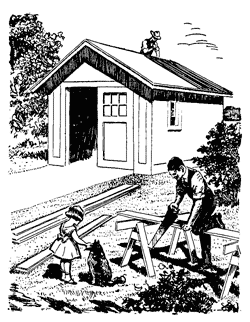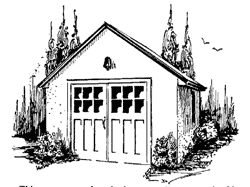Small Home Gazette, Winter 2012
Maintaining and Repairing Old Garages
 We’ve all seen garages that suffer from geriatric conditions. They’re listing, leaning, cracking, crumbling and rotting. Such problems can often be repaired, but prevention is usually the better course. Entirely new garages must meet setback ordinances, so homeowners with limited space and structurally sound old garages are often better off repairing and maintaining what they’ve got.
We’ve all seen garages that suffer from geriatric conditions. They’re listing, leaning, cracking, crumbling and rotting. Such problems can often be repaired, but prevention is usually the better course. Entirely new garages must meet setback ordinances, so homeowners with limited space and structurally sound old garages are often better off repairing and maintaining what they’ve got.
Below are some common issues with old garages and suggested solutions.
The Foundation
Unlike today’s garages, which are built on cinderblocks or a concrete slab, most old garages were built directly on the soil. This constant contact with ground moisture can lead to rotting sills and studs. This is more common in older garages, as the siding often goes all the way to the ground. (New garages are built on block foundations and siding starts 6 to 8 inches above the exterior soil grade.)
 Push soil and other organic matter away from your garage foundation. It may have built up over time or been added for raised garden beds. Keep plants away from the garage walls. They can inhibit walls from drying. A foot of space is recommended for good airflow.
Push soil and other organic matter away from your garage foundation. It may have built up over time or been added for raised garden beds. Keep plants away from the garage walls. They can inhibit walls from drying. A foot of space is recommended for good airflow.
Trees next to a garage can grow under foundations, causing them to heave or crack. Plant trees allowing space for their mature size and remove volunteer trees and woody shrubs, such as buckthorn, before they begin to mature.
When planning projects such as sidewalks, patios or garden beds, construct them so that water flows away from foundations.
Stucco Condition
Cracks and holes in a garage’s stucco are not necessarily a structural issue, according to Larry Baker of Think Stucco (formerly Donnelly Brothers Stucco). They only need to be repaired for cosmetic reasons. Baker explains that a stucco wall might have loosened and feel like it’s floating or has a hollowed effect. Says Baker, “That’s OK. The stucco could support itself and stay like that for another 20 years.”
Baker has observed many garages where the stucco on the alley side is breaking down. He believes road salt that gets shoveled or snow-blown up against the stucco has a negative impact. Salt also accelerates the corrosion of the galvanized metal lath that supports some stucco.
Structural Issues
A leaning garage could be the result of the foundation settling. Old garages should have finished settling unless the land nearby has had some type of change. Depending on the extent and cause of the tilt, some garages can be returned to square with winches, jacks and reinforced supports.
Garages that are still sufficiently sound can be jacked up and have a foundation dug and footings poured or cinderblock foundation built. Some garages look saddle worn, with dipping, swayback roofs. Trusses rotting from rain seepage may cause a sagging roof. Maintain and repair the roof structure and re-shingle to prevent leaking.
Some vintage garages have been neglected for too long or suffered damage beyond repair. If you plan to build a new garage, consider building it in the same style as your bungalow. Bungalow garages were often built to match the house, with the same siding, roof style and architectural details, such as rafter tails. At a minimum, have the paint and color schemes match, as well as the style of the doors, trim, and windows to create a sense of continuity between the structures.











